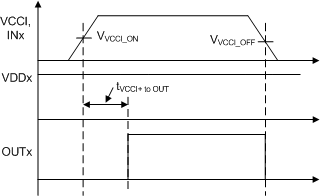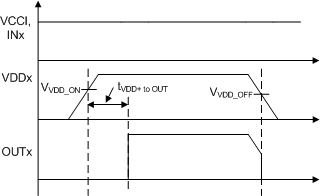JAJSEW6B February 2018 – February 2024 UCC21222
PRODUCTION DATA
- 1
- 1 特長
- 2 アプリケーション
- 3 概要
- 4 Pin Configuration and Functions
-
5 Specifications
- 5.1 Absolute Maximum Ratings
- 5.2 ESD Ratings
- 5.3 Recommended Operating Conditions
- 5.4 Thermal Information
- 5.5 Power Ratings
- 5.6 Insulation Specifications
- 5.7 Safety-Related Certifications
- 5.8 Safety-Limiting Values
- 5.9 Electrical Characteristics
- 5.10 Switching Characteristics
- 5.11 Thermal Derating Curves
- 5.12 Typical Characteristics
- 6 Parameter Measurement Information
- 7 Detailed Description
-
8 Application and Implementation
- 8.1 Application Information
- 8.2
Typical Application
- 8.2.1 Design Requirements
- 8.2.2
Detailed Design Procedure
- 8.2.2.1 Custom Design With WEBENCH® Tools
- 8.2.2.2 Designing INA/INB Input Filter
- 8.2.2.3 Select Dead Time Resistor and Capacitor
- 8.2.2.4 Select External Bootstrap Diode and its Series Resistor
- 8.2.2.5 Gate Driver Output Resistor
- 8.2.2.6 Estimating Gate Driver Power Loss
- 8.2.2.7 Estimating Junction Temperature
- 8.2.2.8 Selecting VCCI, VDDA/B Capacitor
- 8.2.2.9 Application Circuits with Output Stage Negative Bias
- 8.2.3 Application Curves
- 9 Power Supply Recommendations
- 10Layout
- 11Device and Documentation Support
- 12Revision History
- 13Mechanical, Packaging, and Orderable Information
6.6 Power-Up UVLO Delay to OUTPUT
Whenever the supply voltage VCCI crosses from below the falling threshold VVCCI_OFF to above the rising threshold VVCCI_ON, and whenever the supply voltage VDDx crosses from below the falling threshold VVDDx_OFF to above the rising threshold VVDDx_ON, there is a delay before the outputs begin responding to the inputs. For VCCI UVLO this delay is defined as tVCCI+ to OUT, and is typically 40 µs. For VDDx UVLO this delay is defined as tVDD+ to OUT, and is typically 22 µs. TI recommends allowing some margin before driving input signals, to ensure the driver VCCI and VDD bias supplies are fully activated. Figure 6-7 and Figure 6-8 show the power-up UVLO delay timing diagram for VCCI and VDD.
Whenever the supply voltage VCCI crosses below the falling threshold VVCCI_OFF, or VDDx crosses below the falling threshold VVDDx_OFF, the outputs stop responding to the inputs and are held low within 1 µs. This asymmetric delay is designed to ensure safe operation during VCCI or VDDx brownouts.
 Figure 6-7 VCCI
Power-Up
UVLO Delay
Figure 6-7 VCCI
Power-Up
UVLO Delay Figure 6-8 VDDA/B
Power-Up
UVLO Delay
Figure 6-8 VDDA/B
Power-Up
UVLO Delay